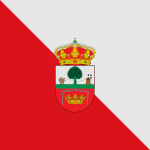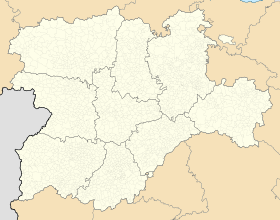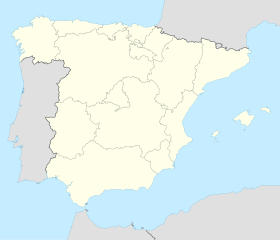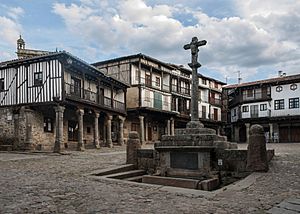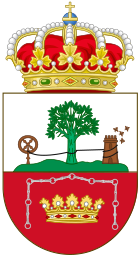La Alberca facts for kids
Quick facts for kids
La Alberca
|
|||
|---|---|---|---|
 |
|||
|
|||
| Country | |||
| Autonomous community | |||
| Province | Salamanca | ||
| Comarca | Tierra de Cantalapiedra | ||
| Area | |||
| • Total | 61 km2 (24 sq mi) | ||
| Elevation | 1,048 m (3,438 ft) | ||
| Population
(2018)
|
|||
| • Total | 1,107 | ||
| • Density | 18.15/km2 (47.0/sq mi) | ||
| Time zone | UTC+1 (CET) | ||
| • Summer (DST) | UTC+2 (CEST) | ||
| Postal code |
37624
|
||
La Alberca is a special town in the Province of Salamanca, Spain. It is part of the Castile and León region. This town is the main center of the Sierra de Francia area.
In 2018, about 1,107 people lived in La Alberca. The town covers an area of about 61 square kilometers. It sits high up in the mountains, about 1,048 meters above sea level.
A special religious place, the Carmelite convent of Batuecas Desert, is nearby. It was started by Thomas á Jesu. It's about 5 kilometers away, but the road to get there is longer, around 12 kilometers.
Contents
What's in a Name? The Etymology of La Alberca
The name "La Alberca" might come from an old Arabic word. This is because Arab people lived in the region for a long time. The Arabic word "berka" means "a lake." When combined with "al," it could mean "the lake."
A Look Back: The History of La Alberca
People have lived in the La Alberca area for a very long time. They were here even before the Romans arrived. We know this because there's an old fort, called a castra, under part of the town. Not many things are left from the Visigoth era. But it's thought that their building materials were used again to build the old Majadas Chapel.
In the 13th century, La Alberca was a special town. It belonged to the crown, which means it was directly under the king's control. It was one of the few places in the Sierra de France that was part of Miranda County.
A Legendary Victory
There's a famous story from 1465. The women of La Alberca supposedly defeated Portuguese troops. They even captured the Portuguese flag! This flag is still kept in the village today. People celebrate this victory on the second day of Easter.
Becoming a Historic Place
In 1940, La Alberca was named a National Historic Landmark. This helped to protect its old buildings and unique style. Since 2000, the Valley of Las Batuecas in La Alberca has also been declared a Historic Site. This valley is where the Batuecas River meets the River Ladrillar.
Important Buildings: The Parish Church
The main church in La Alberca is called the Parish Church of Our Lady of the Assumption. It was finished in the 18th century, in the same year as the New Cathedral of Salamanca (1733).
Church Features
The church has a very old and special pulpit. It's made of polychrome granite and dates back to the 16th century. The church is also known for a special statue called the Blessed Christ of the Sweat.
The church tower is much older than the rest of the church. It was built about 212 years before the current church. The first Duke of Alba paid for it, and his family's symbol can still be seen on the tower. Records from 1693 show that the tower had a clock and bells. In 1520, people even donated their rings and silver jewelry to help make the bells.
Other Religious Places to See
The Natural Park of Las Batuecas has many sacred spots and old caves. Since 1599, the Carmelite monastery has been a very important spiritual center. Inside this area, there are 18 small chapels called hermitages. Some can be visited, while others are now in ruins.
Shrine of Our Lady of Old Majadas
The Shrine of Our Lady of Old Majadas is about 3 kilometers away. It's hidden in a forest of chestnut and oak trees. The statue of the Virgin Mary is from the 12th century and has a simple, beautiful Romanesque style. The chapel itself is also Romanesque, with an outdoor granite pulpit. The town has its own procession for this Virgin.
Hermitage of Cristo del Humilladero
The Hermitage of Cristo del Humilladero (the Humiliated Christ) is the oldest chapel in the town. It's located right inside the village. It sits at the main entrance, where the old road from Salamanca used to be. The statue of the Cristo Humilladero is carried in a procession during Holy Thursday.
Hermitage of San Blas
The Hermitage of San Blas used to be the village cemetery. It's no longer used for worship. However, it's very important to locals for a special event called "The Flag Day." On this day, they carry a banner that the townswomen supposedly captured from the Portuguese in 1475. This celebration includes wine, which was once paid for by the Duke of Alba, and now by the town of La Alberca.
Sanctuary of the Virgin of Peña de Francia
The Sanctuary of the Virgin of the Peña de Francia is a Marian shrine. It's located at the very top of a mountain, at an altitude of 1,723 meters. Dominican friars built it in the 15th century. A Frenchman named Simon Vela discovered the Virgin statue in the 15th century.
Local Life: Culture in La Alberca
The people of La Alberca have many strong traditions. Their town life, including how they celebrate births and deaths, is shaped by religious customs. You can see these traditions in the town's culture and its old buildings. The streets of La Alberca even have religious symbols carved in stone.
Delicious Food in La Alberca
Black Ham is very popular in La Alberca. There are special shops selling large legs of different types of ham. The town also has old Tapas Bars. These bars still look medieval inside, with dark interiors. They keep old Spanish bar customs alive. You can eat tapas like Jamon, Chorizo, and Salami there. There's even a custom where people drink "red water." The restaurant in the main village square is also kept in its old style. It has beautiful ceilings, lovely paintings, and old-fashioned fireplaces. It serves delicious Jamon too.
Fun Events and Festivals
Our Lady of the Assumption Fiesta
On August 15, La Alberca celebrates the fiesta in honor of Our Lady of the Assumption. It's a grand event with colorful costumes and traditional folk dances. The next day, they perform a play called the "loa." This play mixes religious and everyday stories. These parties are so special that they are recognized as being of National Tourist Interest.
The Pig of San Antón
La Alberca has a unique tradition involving a pig! A pig is allowed to roam freely in the streets, and the neighbors feed it. This pig is named "San Anton." On June 13, the pig is blessed. Then, on January 17, which is Saint Anthony's feast day, the pig is raffled off outside the church. The money raised goes to help the Brothers of St Antony.
Other Celebrations
- On September 8, there's a festival at the Peña de Francia.
- The pilgrimage to Old Majadas is celebrated on the Saturday before Pentecost.
- In November, people celebrate the Calbochada. This is when they roast chestnuts in the town square and enjoy local folklore.
- On February 2, they celebrate the feast of the candles. This includes a procession of the Virgin of the Assumption.
Local Legends
- The Virgin of Maralviejas, or Old Majadas, was found among rocks by a hermit named Froilan.
- A tradition says that on September 1, 1655, a statue of Christ, called El Cristo del Sudor (The Christ of the Sweat), sweated blood. The next day, it bled from a wound in its side.
See also
 In Spanish: La Alberca (Salamanca) para niños
In Spanish: La Alberca (Salamanca) para niños


